-
 Iron tsuba of round form with two ebi (lobster) on omote (obverse side) and shika (deer) among scattered momiji (maple leaves) on ura (reverse side) motif in brass takabori (high relief) suemon-zōgan. Traces of lacquer. Unsigned. Late Muromachi / Momoyama period (late 16th / Early 17th century). Dimensions: 69.0.6 mm (H) x 69.6 mm (W) x 3.4 mm (T, seppa-dai). Weight: 92.6 g. Illustrated at: The Lundgren Collection of Japanese Swords, Sword Fittings and A Group of Miochin School Metalwork. Christie's Auction: Tuesday, 18 November 1997, London. Sales "GOTO-5881". Christie's, 1997. - #2 at page 7. Provenance: The second John Harding; The Lundgren Collection. Description at Christie's: "The iron plate depicting two lobsters in takabory and brass takazogan, the reverse similarly decorated with deer among scattered maple leaves, square mimi, late Muromachi / early Momoyama period (late 16th/early 17th century) Diameter 68 mm, mimi thickness 4 mm. Provenance: The second John Harding." Also at: JAPANESE SWORD-FITTINGS & METALWORK IN THE LUNDGREN COLLECTION. Published by Otsuka Kogeisha, Tokyo 1992. № 134. Description on page 173: Sword guard with design of shrimps in inlay (scarlet [sic] maple leaves and deer on the reverse side). Unsigned. Heianjō inlay school. Vertical 6.85 cm, horizontal 6.90 cm, Th. of rim 0.40 cm. Iron. Taka-bori relief and brass inlay. Momoyama period, 16th - 17th century. According to Merrily Baird, maple leaves, especially if paired with the deer, allude to autumnal tradition of Japanese aristocracy of viewing the seasonal changes of color in the Nara area. The lobster is typical Japanese ebi, - it lacks prominent claws, and has a spiny shell. As a symbol of longevity and good fortune, lobster is a staple of New Year's decoration.
Iron tsuba of round form with two ebi (lobster) on omote (obverse side) and shika (deer) among scattered momiji (maple leaves) on ura (reverse side) motif in brass takabori (high relief) suemon-zōgan. Traces of lacquer. Unsigned. Late Muromachi / Momoyama period (late 16th / Early 17th century). Dimensions: 69.0.6 mm (H) x 69.6 mm (W) x 3.4 mm (T, seppa-dai). Weight: 92.6 g. Illustrated at: The Lundgren Collection of Japanese Swords, Sword Fittings and A Group of Miochin School Metalwork. Christie's Auction: Tuesday, 18 November 1997, London. Sales "GOTO-5881". Christie's, 1997. - #2 at page 7. Provenance: The second John Harding; The Lundgren Collection. Description at Christie's: "The iron plate depicting two lobsters in takabory and brass takazogan, the reverse similarly decorated with deer among scattered maple leaves, square mimi, late Muromachi / early Momoyama period (late 16th/early 17th century) Diameter 68 mm, mimi thickness 4 mm. Provenance: The second John Harding." Also at: JAPANESE SWORD-FITTINGS & METALWORK IN THE LUNDGREN COLLECTION. Published by Otsuka Kogeisha, Tokyo 1992. № 134. Description on page 173: Sword guard with design of shrimps in inlay (scarlet [sic] maple leaves and deer on the reverse side). Unsigned. Heianjō inlay school. Vertical 6.85 cm, horizontal 6.90 cm, Th. of rim 0.40 cm. Iron. Taka-bori relief and brass inlay. Momoyama period, 16th - 17th century. According to Merrily Baird, maple leaves, especially if paired with the deer, allude to autumnal tradition of Japanese aristocracy of viewing the seasonal changes of color in the Nara area. The lobster is typical Japanese ebi, - it lacks prominent claws, and has a spiny shell. As a symbol of longevity and good fortune, lobster is a staple of New Year's decoration. -

Iron tsuba of round form with brown patina decorated with the design of a Buddhist temple bell (tsurigane) in openwork (sukashi), with details outlined in brass wire (sen-zōgan), the outer ring decorated with two rows of brass dots (ten-zōgan), and the bell details carved in sukidashi-bori as on kamakura-bori pieces.
Ōnin school. Unsigned. Late Muromachi period, 16th century. Dimensions: 88.8 x 88.3 x 3.0 mm. As per Merrily Baird, two legends are usually associated with the image of tsurigane, a large, suspended Buddhist bell: one is that of Dojo Temple (Dojo-ji), and the other is of Benkei stealing the tsurigane of Miidera Temple. Interestingly, this type of bell (tsurigane) is not described as a family crest (mon), while suzu and hansho bells are. -
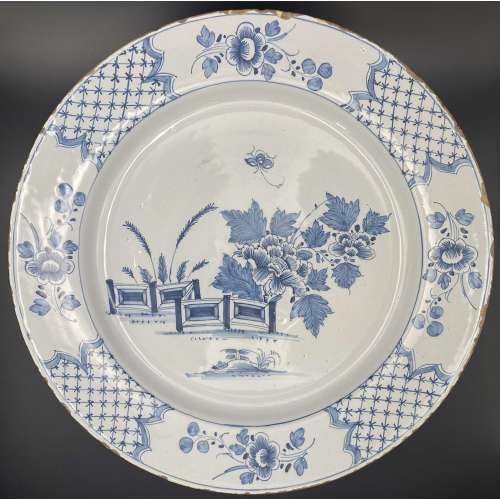 Round plate with a blue and white design of blossoming peony behind a fence with lattice and floral border; flowers to the bottom. Diameter: 33 cm, Haight: 4.5 cm.
Round plate with a blue and white design of blossoming peony behind a fence with lattice and floral border; flowers to the bottom. Diameter: 33 cm, Haight: 4.5 cm. -

Iron tsuba of round form inlaid with brass and shakudo (suemon-zōgan) with a design of tendrils, leaves, double gourds, and folding fan with two wild geese on the face and the same design only with a fan with two interlocked rings (wachigai) on the back. Design is supplemented with a round family crest (mon) of three fans in openwork (sukashi). Hitsu-ana and the mon are outlined with brass rope. Copper sekigane.
Some attribute such tsuba as belonging to Heianjō or even Yoshirō School, and date them to Momoyama period. I keep this piece under Ōnin rubric, late Muromachi, but this is just a question of personal preference.Some inlay is missing, some repaired; traces of rust. Otherwise - decent condition.
Late Muromachi period (1514-1573). Size: 77.4 x 77.1 x 3.8 (center), 3.2 (rim) mm -
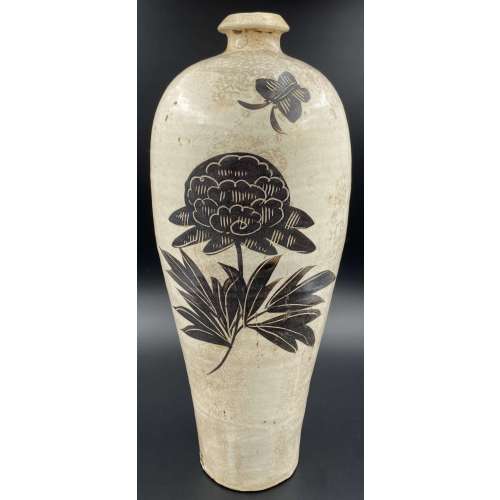 Typical meiping body, short neck, lipped rim; painted in the blackish-brown slip with two blossoms and butterflies under a clear glaze. The foot ring is unglazed exposing the brown body. China, the Yuan Dynasty [大元] (1279 – 1368). Diameter: 14 cm; Height: 30.5 cm.
Typical meiping body, short neck, lipped rim; painted in the blackish-brown slip with two blossoms and butterflies under a clear glaze. The foot ring is unglazed exposing the brown body. China, the Yuan Dynasty [大元] (1279 – 1368). Diameter: 14 cm; Height: 30.5 cm. -
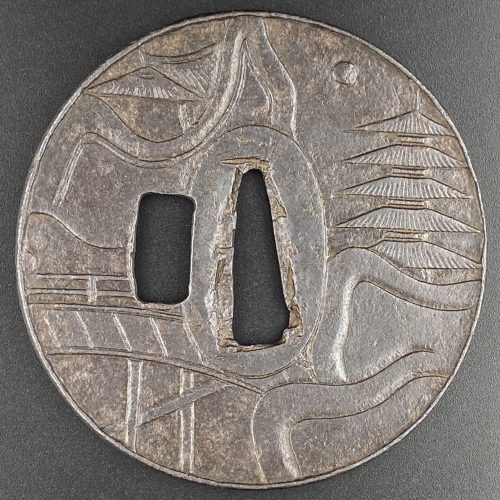
The thin iron plate of round form and black colour carved in sukidashi-bori with the design of rocks, waves, bridge, mountain pavilion and 5-storey pagoda under the moon, on both sides, alluding to Todai-ji temple in Nara. Slightly rounded rectangular hitsu-ana probably pierced later. Very narrow raised rim as usual in katsushi tsuba. In a modern wooden box.
Late Muromachi period, 16th century. Dimensions: 81.1 x 79.5 x 3. mm (seppa-dai), 2.2 mm (base plate), 4.4. (rim).Reference: “Art of the Samurai” on page 232, №140: ”Kamakura tsuba with Sangatsu-do tower and bridge. Muromachi period, 16th century. 83 mm x 80 mm. Unsigned. Tokyo National Museum. The mountain pavilion and bridge carved in sunken relief on the iron tsuba – both part of Tōdai-ji, a temple in Nara – are detailed in fine kebori (line) engraving. As a result of the chiselling used to create the relief, the ground of the piece is relatively thin”. Also page 41 in Tsuba Kanshoki. Kazutaro Torogoye, 1975 [LIB-1480.2018].
This tsuba is very much similar to TSU-0384. -
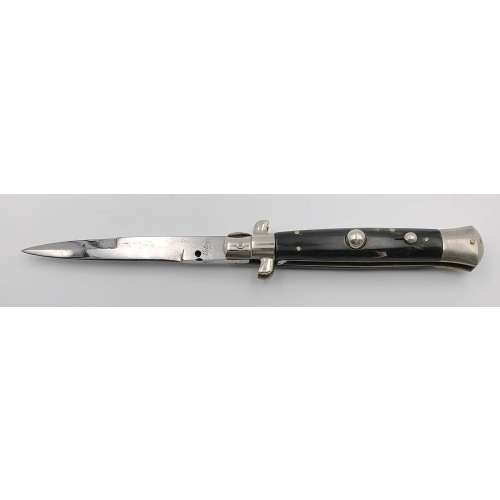
Classical picklock Italian stiletto switchblade knife with bolster release, fixed guard, Brazilian horn handle.
Size: 112 mm (closed); 240 mm (opened); 90 mm blade.
Tang is etched with: Latama, Italy. SOLD -
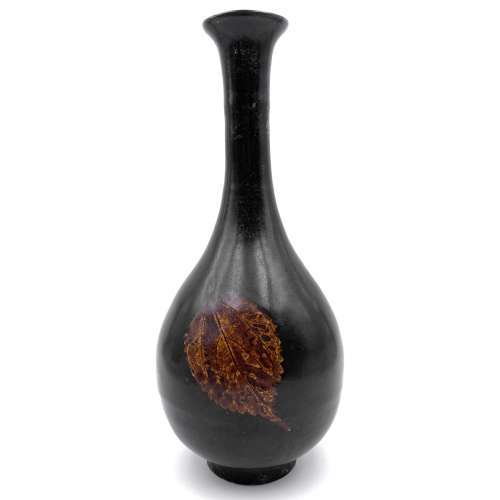 Jizhou black glaze bottle decorated with a leaf, placed on to the glaze before firing, and burnt away in the kiln to leave its pattern. Foot unglazed. China, the Song dynasty [宋朝] (960 – 1279). Height: 27.5 cm.
Jizhou black glaze bottle decorated with a leaf, placed on to the glaze before firing, and burnt away in the kiln to leave its pattern. Foot unglazed. China, the Song dynasty [宋朝] (960 – 1279). Height: 27.5 cm. -
 Six-lobed iron tsuba in a form of three ginkgo tree leaves (icho), separated with three small triangular openings (ko-sukashi). Leaves have raised rim and decorated with various family crests (mon) in low relief carving (sukidashi-bori). On obverse: bamboo stems and leaves, knotted geese, paulownia (kiri), plum blossom (ume), and ivy. On reverse: pine needles and cone, maple leaf (kaede), bamboo, stylized plum blossom, and Genji-mon. Black patina. Kozuka hitsu-ana is original, with raised rim. Copper sekigane. Kamakura-bori school. Late Muromachi period (ca. 1550). Size: Height: 81.1 mm. Width: 90.0 mm. Thickness at seppa-dai: 3.3 mm. Weight: 120.4 g.
Six-lobed iron tsuba in a form of three ginkgo tree leaves (icho), separated with three small triangular openings (ko-sukashi). Leaves have raised rim and decorated with various family crests (mon) in low relief carving (sukidashi-bori). On obverse: bamboo stems and leaves, knotted geese, paulownia (kiri), plum blossom (ume), and ivy. On reverse: pine needles and cone, maple leaf (kaede), bamboo, stylized plum blossom, and Genji-mon. Black patina. Kozuka hitsu-ana is original, with raised rim. Copper sekigane. Kamakura-bori school. Late Muromachi period (ca. 1550). Size: Height: 81.1 mm. Width: 90.0 mm. Thickness at seppa-dai: 3.3 mm. Weight: 120.4 g. -
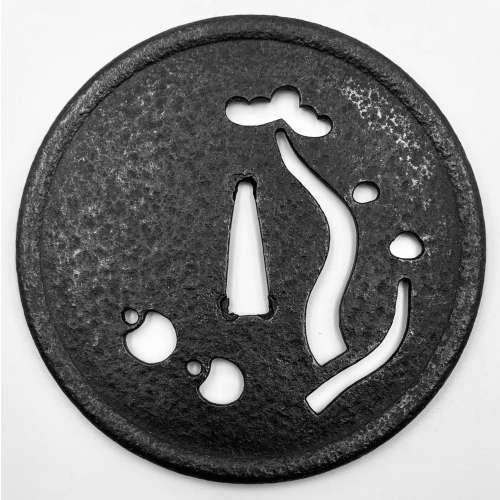
Iron tsuba of circular form with design of pine trees (matsu) and monkey toys (kukurizaru) in openwork (ko-sukashi). Ko-Katchushi school.
Raised rim (mimi) with iron bones (tekkotsu). Size: Diameter: 99.5 mm; Thickness: 2.1 mm at centre; 4.3 mm at the rim.Early Muromachi period: 15th century (Kakitsu - Bun'an era, 1441 - 1449).
-
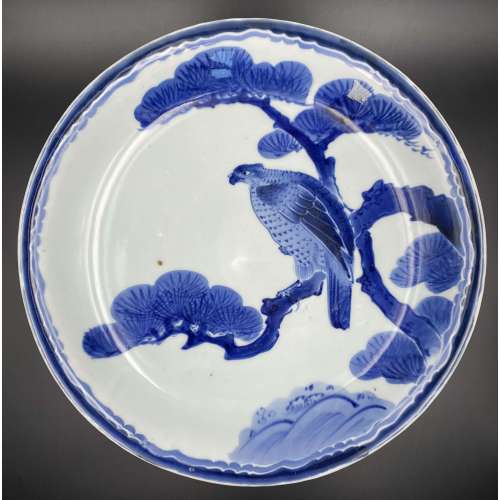 Underglaze cobalt blue and white porcelain plate decorated with a falcon on a pine tree and rough waves beneath; rim with a stylized wave design; seven spur marks on the reverse. Diameter: 31 cm; Height: 5 cm; Diameter of the foot: 18 cm.
Underglaze cobalt blue and white porcelain plate decorated with a falcon on a pine tree and rough waves beneath; rim with a stylized wave design; seven spur marks on the reverse. Diameter: 31 cm; Height: 5 cm; Diameter of the foot: 18 cm. -
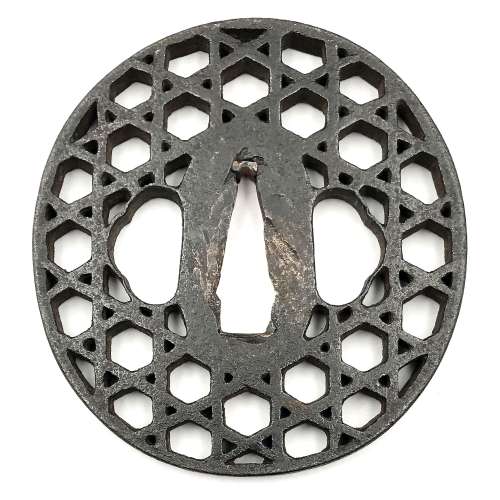
Iron tsuba of oval form decorated with design of jakago (bamboo lattice work) in openwork (sukashi). Copper sekigane.
Unsigned. Edo period.
Size: 73.7 x 70.3 x 5.6 mm.Note regarding design: though some might think that this piece belonged to a member of the lost tribe of Israel, it did not. Jakago baskets were made of bamboo, filled with rocks and used to catch crabs (besides other uses).
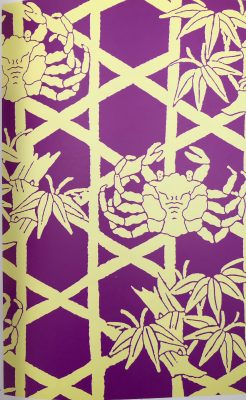
Jeanne Allen. Designer's Guide to Samurai Patterns. Chronicle Books, San Francisco, 1990; p.51, №57.
-
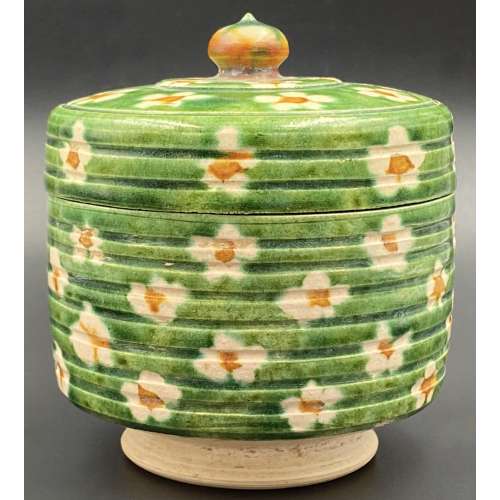 Green, mottled (white, yellow, brown) glazed earthenware jar or a circular box with a cover, on an unglazed foot decorated with florets. The cover has a small knop. Ivory glaze inside. China, the Tang dynasty [唐朝] (618 – 907). Diameter: 10 cm; Height: 10 cm.
Green, mottled (white, yellow, brown) glazed earthenware jar or a circular box with a cover, on an unglazed foot decorated with florets. The cover has a small knop. Ivory glaze inside. China, the Tang dynasty [唐朝] (618 – 907). Diameter: 10 cm; Height: 10 cm. -
 Iron tsuba of round form, tapering from centre to the rim, decorated with eight roundels – circular emblems of flowers and/or family crests (mon) made of cast brass, pierced and chiselled in kebori, and with flat brass inlay (hira-zōgan) of water plantain (omodaka) and seaweed all over the plate. Hitsu-ana outlined in brass. Four positive silhouette roundels are 3-, 6-, 9-, and 12 – pointing crests/flowers; four negative silhouette roundels – bellflower, cherry and plum blossoms. Yoshirō school (Kaga-Yoshirō). Unsigned. The Momoyama or early Edo period, end of the 16th to the first half of the 17th century (1574-1650). Size: H: 88.3 mm; W: 88.7 mm; Thickness 4.0 mm (Seppa-dai), 3,2 cm (rim). Other Kaga-Yoshiro tsuba in this collection: TSU-0334: 7.7 cm; TSU-0342.2017: 89.6 cm; TSU-0344: 8.1 cm; TSU-0329: 8.0 cm; TSU-0376.2018: 8.1 cm; TSU-0379.2018: 8.2 cm. We see that the usual size is about 8 cm; larger pieces, such as this one and TSU-0342.2017 dedicated to Hachiman, are rare. Article about Yoshiro tsuba.
Iron tsuba of round form, tapering from centre to the rim, decorated with eight roundels – circular emblems of flowers and/or family crests (mon) made of cast brass, pierced and chiselled in kebori, and with flat brass inlay (hira-zōgan) of water plantain (omodaka) and seaweed all over the plate. Hitsu-ana outlined in brass. Four positive silhouette roundels are 3-, 6-, 9-, and 12 – pointing crests/flowers; four negative silhouette roundels – bellflower, cherry and plum blossoms. Yoshirō school (Kaga-Yoshirō). Unsigned. The Momoyama or early Edo period, end of the 16th to the first half of the 17th century (1574-1650). Size: H: 88.3 mm; W: 88.7 mm; Thickness 4.0 mm (Seppa-dai), 3,2 cm (rim). Other Kaga-Yoshiro tsuba in this collection: TSU-0334: 7.7 cm; TSU-0342.2017: 89.6 cm; TSU-0344: 8.1 cm; TSU-0329: 8.0 cm; TSU-0376.2018: 8.1 cm; TSU-0379.2018: 8.2 cm. We see that the usual size is about 8 cm; larger pieces, such as this one and TSU-0342.2017 dedicated to Hachiman, are rare. Article about Yoshiro tsuba. -
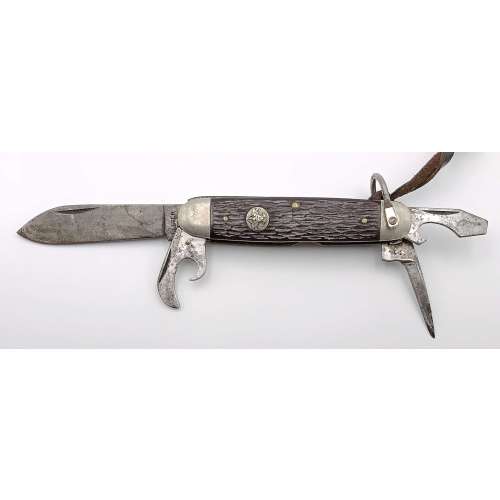
Ulster Official Scout pocket knife with brown jigged bone plastic handles.
Size: 93 mm (closed); 160 mm (opened); 70 mm blade.
Tang is etched with: Ulster -
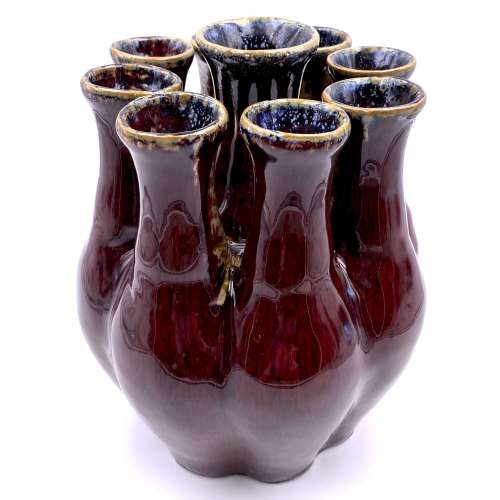 Porcelaneous stoneware vase glazed in purple-red with blue and beige splashes outside and dark blue inside, with one tube in the centre surrounded with eight peripheral tubes. Base unglazed. China, the Qianlong period (1711 – 1799) of the Qing Dynasty (1644 – 1912). Diameter: 19 cm; Height: 24 cm.
Porcelaneous stoneware vase glazed in purple-red with blue and beige splashes outside and dark blue inside, with one tube in the centre surrounded with eight peripheral tubes. Base unglazed. China, the Qianlong period (1711 – 1799) of the Qing Dynasty (1644 – 1912). Diameter: 19 cm; Height: 24 cm. -
 Iron tsuba of round form with design of rabbit (usagi) in openwork (sukashi) and inlaid with designs of plants and family crests (mon) in suemon-zōgan. A branch with lonely leaf, half chrysanthemum, and flying wild geese on the face represent autumnal connotations. The same motif is complemented by a clove (choji) on the reverse. The family crests (mon) include: interlocked rings (kanawa; wachigai), three encircled lines or stripes (hikiryo), bit or muzzle (kutsuwa - horse's harness element with possible christian symbolism), and encircled triangle (uroko, fish scale). Brass wire trim around the openwork elements and the seppa-dai, scalloped wire inlay around the hitsu-ana. Iron is dark, almost black. Brass or copper elements vary in shades of lighter and darker yellow with red-ish hue. Ōnin school. Late Muromachi period, 16th century. Height: 89.6 mm; Width: 89.3 mm; Thickness at seppa-dai: 3.0 mm. Weight: 129.7 g.
Iron tsuba of round form with design of rabbit (usagi) in openwork (sukashi) and inlaid with designs of plants and family crests (mon) in suemon-zōgan. A branch with lonely leaf, half chrysanthemum, and flying wild geese on the face represent autumnal connotations. The same motif is complemented by a clove (choji) on the reverse. The family crests (mon) include: interlocked rings (kanawa; wachigai), three encircled lines or stripes (hikiryo), bit or muzzle (kutsuwa - horse's harness element with possible christian symbolism), and encircled triangle (uroko, fish scale). Brass wire trim around the openwork elements and the seppa-dai, scalloped wire inlay around the hitsu-ana. Iron is dark, almost black. Brass or copper elements vary in shades of lighter and darker yellow with red-ish hue. Ōnin school. Late Muromachi period, 16th century. Height: 89.6 mm; Width: 89.3 mm; Thickness at seppa-dai: 3.0 mm. Weight: 129.7 g. -

Iron tsuba of round form pierced (sukashi) and inlaid in flat (hira-zōgan) and cast brass (suemon-zōgan), details carved in kebori, with design of two phoenixes, bamboo, and paulownia leaves and flowers (kiri-mon) on both sides. According to seller: Bizen-Yoshirō school (or Heianjō school). Unsigned.
Momoyama period. End of the 16th - beginning of the 17th century. Dimensions: Diameter: 99.5 mm; Thickness: 2.1 mm at centre; 4.3 mm at the rim. According to Merrily Baird (Symbols of Japan), "bamboo teamed with paulownia blossoms or with paulownia and the phoenix, in reference to the Chinese legend that the phoenix perches only on the paulownia and eats only the bamboo". Citation from http://www.clevelandart.org/art/1986.2.1: "The immense heraldic birds on display [...] reflect the Momoyama era's spirit of newly gained self-confidence and an affinity for grand expressive statements in painting, architecture, the textile and ceramic arts, as well as garden design. While that period preceded the arrival of prosperity, it clearly marked an extraordinary moment in Japanese cultural history, one frequently compared with the twelfth century of the Heian period. [...] Rather than an emblem of immortality, as it is in Western lore, in Japan, the phoenix evolved out of its origins in Chinese mythology to become, by the sixteenth century, an auspicious symbol of political authority. Together with clusters of the distinctively shaped paulownia leaves, this long-tailed, mythical bird [...] proclaiming an air of graceful command".


